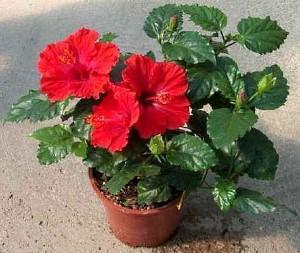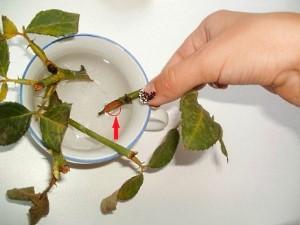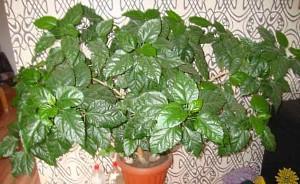Chinese rose - growing conditions and signs about the flower
 Hibiscus (Chinese rose) is a tall, beautiful plant with large, bright blooms of various colors. The beautiful flower is a favorite among experienced gardeners and amateurs. He is not whimsical in care and cultivation, and these are the main qualities of the rapid and unhindered growth of the plant.
Hibiscus (Chinese rose) is a tall, beautiful plant with large, bright blooms of various colors. The beautiful flower is a favorite among experienced gardeners and amateurs. He is not whimsical in care and cultivation, and these are the main qualities of the rapid and unhindered growth of the plant.
How the Chinese rose blooms
The Chinese rose (indoor) is quite popular among flower growers, not only because of its easy maintenance, but also because of its beautiful flowers. They delight with their inflorescences for a short time, only two or three days. But on the bush, new opening buds constantly appear, one after the other. Therefore, it seems that hibiscus blooms for a long time. But this is provided that this bush is complete and healthy. A photo of a Chinese rose taken during the flowering period is a stunning sight.
The color scheme of the plant can be red and white, purple and orange, and one bud is able to combine two palettes. Nowadays, specialty shops offer low-growing varieties of hibiscus (Dutch hybrids).
Growing a Chinese rose at home - the transplant stage
The main rules for growing a Chinese rose at home is its transplantation and reproduction. A young plant is transplanted in the spring into prepared soil. The flower loves fertilizers.
What is mixed for nutrient earth:
- sod soil (4 kg);
- deciduous soil (3 kg);
- humus soil (1 kg);
- sand (1 kg).
A layer of drainage is placed in the container in which the hibiscus will be planted. The flower is fast growing, so plant transplanting may be required several times a year. Young shoots are cut off. Already the "adult" Chinese rose is not disturbed by transplants, but simply remove the top layer of soil and replace it with a nutritious one.
Growing process - propagation of a Chinese rose by cuttings
All plants have several methods of propagation.
How to breed hibiscus:
- using seeds;
- by dividing the bush;
- layering;
- cuttings .
Most often, cuttings are used as planting material. They are able to quickly release roots and grow. The propagation of a Chinese rose by cuttings is not a difficult process.
In any summer month, you need to cut off the top of the young shoot. It is important that there are at least two internodes on the planting material.

It is better if the transplanted cuttings grow in a warm temperature regime (minimum 22 degrees, maximum - 25). Thirty days later, the young shoot will fully take root.
Top dressing for Chinese rose
The Chinese rose (indoor) is very responsive to fertilizers. The plant is fed only in the warm season: in spring or summer. In cold weather, hibiscus easily dispenses with additional nutrients. Fertilizers are applied once every two weeks.
For feeding indoor flowers, there are a lot of complex "nutrition". They are best purchased at flower shops.
The composition of fertilizers should include the following elements:
- potassium;
- phosphorus;
- nitrogen.
For the full growth of the Chinese rose, you need to feed its horse system, with a frequency of once a month. All fertilizers are best diluted in warm, settled water. Also, substances containing nitrogen should be sprayed with plant greens.Do not let the solution get on the hibiscus flowers, this can lead to stains on them.
You should not "overfeed" or "underfeed" the flower with fertilizers, as the plant can die. It is because of this that the leaves of the Chinese rose turn yellow. Gradually, all the greens will fall off.
What to do when the castings of a Chinese rose turn yellow
If yellow spots began to appear on the leaves of the hibiscus, this means that the plant has undergone a disease. Over time, all the greenery will begin to spin and dry, as a result, it will fall off and the flower will die.
If you carefully examine the Chinese rose, you can see a tick. This parasite is very dangerous for the plant, therefore, its neutralization is required. How to do it?
Need to spray hibiscus leaves pesticides, for example, "Aktelik" or "Fitoferm". These substances are used to treat indoor flowers. To completely defeat the parasite (tick), it is worth disinfecting the plant at least three times. This procedure needs to be done once a week.
Experienced growers know that the best fight against flower diseases is prevention. To do this, it is worth treating the Chinese rose with disinfectants once a month.
Chinese rose care required
 Chinese rose care is required at a young age and during the flowering period. These two steps will ensure the healthy growth of a beautiful plant.
Chinese rose care is required at a young age and during the flowering period. These two steps will ensure the healthy growth of a beautiful plant.
Caring for a transplanted cuttings is the formation of the crown. As soon as the planting material is fully rooted and began to gain height intensively, it should be pinched. Only in this case will the Chinese rose grow lush and blooming.
Hibiscus care during flowering:
- ensuring a sufficient amount of sunlight (but not direct hits of rays on the leaves of the plant);
- top dressing of the soil;
- watering with warm water;
- spraying.
 As a fertilizer, you can use a weak sweet syrup of your own preparation. This requires one teaspoon of sugar and 250 grams of warm liquid. Mix the ingredients until completely soluble.
As a fertilizer, you can use a weak sweet syrup of your own preparation. This requires one teaspoon of sugar and 250 grams of warm liquid. Mix the ingredients until completely soluble.
In the summer, when the heat is intense, it is advisable to take the hibiscus (Chinese rose) to the balcony. Place it in a corner where there is no direct sunlight, but good daylight is available. These conditions will ensure abundant flowering.
The Chinese rose is a water-loving plant. Watering in the summer should be done frequently. You can do it every day - morning and evening. Also, the flower should be sprayed.
Pruning shoots has a beneficial effect on the growth and flowering of the Chinese rose. It is necessary to examine the bush and identify weak branches. They are cut off first, leaving only a two centimeter long shoot from the buds with leaves. The crown is also cut to make the flower decorative. If the shoots are cut correctly, the plant will be lush and formed.
Chinese rose diseases
Improper care of the Chinese rose can lead to the appearance of diseases.
The most common diseases of the Chinese rose:
- fungal infection;
- spider mite;
- aphid;
- felt maker.
 Symptoms of a fungal infection include blackening of the leaves and drooping of buds. In order to avoid this disease, it is not necessary to overmoisten the soil, and also to prevent drafts and a sharp drop in temperature.
Symptoms of a fungal infection include blackening of the leaves and drooping of buds. In order to avoid this disease, it is not necessary to overmoisten the soil, and also to prevent drafts and a sharp drop in temperature.
Aphids and felts are spread by dry air and improper watering.
Signs about the Chinese rose
Every florist has heard many signs about the Chinese rose. Many of them are negative, although there are also positive ones.
Signs about a Chinese rose:
- growing a flower in the house where the family lives will bring quarrels between husband and wife;
- if the unplanned plant pleased with flowering, then troubles are coming soon;
- leaves fell for no apparent reason - it is worth waiting for the illness of one of the family members;
- the abundant flowering of hibiscus in the home of an unmarried girl promises an imminent meeting with a gentleman.
It is because of the not very good fame of the Chinese rose that it is grown not in residential buildings, but in administrative buildings and various institutions. Blindly believing all the signs, of course, is not worth it, because the falling leaves or sudden flowering can only be the result of improper care of the plant. See photo of garden hibiscus!
zamiokulkas blooms, and bizarre
Hello! I would like to know what kind of flower is growing in me?
Hello, I have such a problem, after the fall of my rose, it stopped blooming, it has not bloomed for two years already and green leaves began to fall off, before it fell, it bloomed almost all year round.
Add a photo if possible.